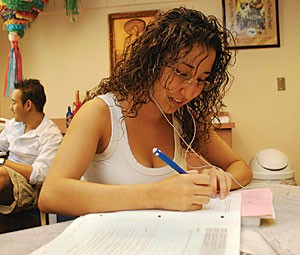The UA will continue on its way to officially becoming a Hispanic-serving institution, a goal that would make 25 percent of the student body Hispanic, said President Robert Shelton.
In 2003, President Emeritus Peter Likins said he wanted the UA to reach this goal within 10 years, but Shelton said he is not going to set a specific deadline for earning this designation.
“”I just want to see progress every year,”” Shelton said Friday, the first day of Hispanic Heritage Month.
Once the UA achieves the 25 percent figure, the organization can add its name to an official list of Hispanic Serving Institutions, according to the Congressional Hispanic Caucus Institute Web site.
“”As far as I’m concerned, that’s fantastic. It means the university is serving the community,”” said Socorro Carrizosa, director of Chicano/Hispano Student Affairs.
While the 2000 census registered a 25
percent Hispanic population in Arizona, that statistic isn’t reflected at any of the state’s three major public universities.
Student enrollment by ethnicity, 2005-2006
| Ethnicity | Freshman | All Undergrads | Grads |
| White/Non-Hispanic | 4,063 | 18,574 | 4,236 |
| Hispanic | 829 | 4,376 | 618 |
| Black | 190 | 859 | 135 |
| Asian/Pacific Islander | 395 | 1,627 | 265 |
| American Indian/Alaskan Native | 132 | 552 | 191 |
Hispanics comprised 13.7 percent of UA students during the last academic year, according to the 2005-2006 UA Fact Book.
The disparity is not lost on the UA’s Hispanic population.
Giselle Celaya, a general biology sophomore who went to high school on Tucson’s south side, said her first day of classes came as a shock.
“”I saw a lot of blonde girls. That was my very first impression, I’ll admit it,”” Celaya said. “”I felt out of place. I was like, ‘Wow, I’m the only brunette.'””
Celaya said some people may feel intimidated by the lack of diversity.
“”They just don’t feel like they fit in, and a lot of people don’t succeed because they don’t feel like, ‘Oh, this is where I belong,'”” Celaya said.
Carrizosa said Likins worked well with C/HSA to establish a campus community that was more welcoming to Hispanic students.
“”Definitely, there was progress made,”” Carrizosa said.
Likins was supportive of the push to rename the CǸsar E. Chǭvez building in name of the civil rights activist and to bring more Latino-influenced art to campus, Carrizosa said.
Shelton said he plans to continue providing funds to programs like C/HAS, and he wants to hire more Hispanic professors, advisers and staff around campus.
“”My experience says the best way to (recruit more Hispanic students) is to talk to the students we already have here and make sure they are doing well, because they are the best ambassadors to their communities,”” Shelton said.
Carrizosa said she thinks the addition of more Hispanic professors will benefit all students, not just Latinos. However, Latino professors would provide a positive example for their students, Carrizosa added.
“”It’s great to see somebody that shares your experience, that looks like you, leading the class,”” Carrizosa said.
Shelton said he is optimistic about reaching the goal because Arizona is home to a large and vibrant Hispanic community that can provide a number of talented students and faculty.
Hispanics are poorly represented in both the faculty and the student body, said Esther del Valle, a pre-education freshman.
Celaya said her first impression of the UA was strange because the recruiters she met at Sunnyside High School, which she said is predominantly Latino, were not Latinos themselves.
“”It’s very discouraging. It’s like, ‘Am I going to fit in? Am I going to be the minority?'”” Celaya said. “”And you are. You really are.””
Celaya said more could be done to reach out to Hispanic teens in Tucson, such as sending Hispanic student volunteers to high schools like Sunnyside.
Celaya said she would go herself because she’s sure it would encourage more Hispanic students to attend the UA.
Hispanic Heritage Month began Friday and will continue until Oct. 15.









